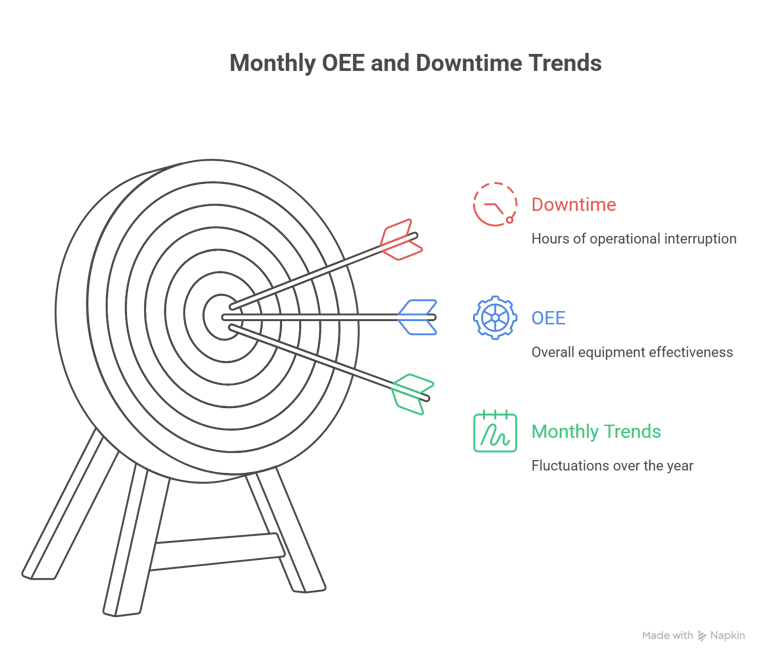
Manufacturing Dashboards: From Production Lines to Performance Metrics
Learn how dashboards for manufacturing turn raw production data into actionable insights. Boost efficiency, quality, and operational visibility.
DATA VISUALIZATION
Key Points
Manufacturing dashboards consolidate data from production, maintenance, quality, and inventory into one real-time view.
They shift decision-making from reactive to proactive, helping teams identify bottlenecks and inefficiencies early.
Key metrics include OEE, downtime, cycle time, yield rate, throughput, scrap rate, inventory turns, and MTBF.
Role-based dashboards empower operators, supervisors, and executives with tailored insights for faster actions.
Predictive analytics and AI in dashboards reduce unplanned downtime and support continuous improvement initiatives.
Dashboards integrate operational and financial data, improving cost control, ROI visibility, and investment justification.
Actionable takeaway: Implement a real-time, role-based manufacturing dashboard tracking 5–8 key metrics and use predictive analytics to optimize operations and reduce downtime.
Introduction
In modern factories, data is everywhere. Machines generate streams of information about speed, errors, maintenance, and more. But raw data alone does not help. To turn data into action, manufacturers use dashboards for manufacturing. These dashboards show key metrics in real time and enable faster, smarter decisions.
In this post, we answer three core questions:
What are manufacturing dashboards and why do they matter?
What key metrics should your dashboard include?
How do dashboards drive performance and better decisions?
At the end, you’ll see How Exology Helps you apply these practices.
What are dashboards for manufacturing, and why do they matter?
A manufacturing dashboard is a visual interface that consolidates data from across the shop floor, machines, production systems, quality systems, maintenance systems, and presents it in one unified view. It turns raw metrics into charts, gauges, tables, and alerts so that decision-makers can see performance at a glance.
Instead of waiting for daily or weekly reports, teams get real-time insight. As data flows in continuously, stakeholders can detect anomalies, compare trends, and spot inefficiencies early.
Why they matter:
They break down silos by aggregating production, maintenance, quality, and inventory data.
They shift decision-making from reactive to proactive, allowing faster interventions.
They drive alignment: operators, supervisors, and executives all view metrics tailored to their roles.
According to MachineMetrics, dashboards let users “track machine health, production performance, and workflow efficiency” so that teams can “address inefficiencies, identify bottlenecks, and implement solutions as quickly as possible.”
GoodData also highlights how dashboards help manufacturers combine production, inventory, quality, and safety metrics in one place, enabling better operational control.
Types of Manufacturing Dashboards
Different users need different perspectives. Here are common dashboard types:
Production dashboards - monitor throughput, cycle time, output rates, machine utilization.
Quality dashboards - show defect rates, yield, scrap, rework metrics.
Maintenance dashboards - track preventive maintenance schedules, downtime, equipment health.
Executive dashboards - offer high-level summaries across departments.


What key metrics should every manufacturing dashboard track?
Choosing the right metrics is essential. Too many, and the dashboard becomes noisy. Too few, and you miss important signals.
Here are eight key metrics your manufacturing dashboard should focus on:
Overall Equipment Effectiveness (OEE)
Measures utilization, performance, and quality across equipment. Many manufacturers consider 85%+ OEE excellent.
Learn more.Downtime (planned / unplanned)
Tracks lost production time and helps identify recurring machine issues.Cycle Time
Measures the time required to complete one production unit and compares ideal vs. actual performance.Yield Rate / First-Pass Yield
Percentage of units produced without rework or defects. A drop signals quality issues.
Reference.Throughput / Output per Hour
Indicates how many units are produced per hour - vital for line balancing.Scrap / Defect Rate
Shows waste levels and quality consistency across production lines.Inventory Turns
Measures how fast raw and finished goods move, helping manage cash flow and storage costs.
See NetSuite guide.Mean Time Between Failures (MTBF)
Evaluates maintenance reliability and helps guide preventive strategies.
Pro tip: Start with 5- 8 KPIs that directly tie to your goals. Add drill-downs for detailed analysis rather than crowding the dashboard with every possible metric.
How do dashboards improve performance and decision-making in manufacturing?
1. Real-time visibility shortens decision cycles
Dashboards deliver live data, enabling faster reaction times. According to Gartner, BI dashboards can reduce the time to identify root causes by 15- 25%. This minimizes production delays and increases agility.
2. Role-based views empower every team
Operators can see machine health and alerts, supervisors track output, and executives monitor plant-wide performance - all from one source of truth.
3. Continuous improvement culture
Dashboards let teams track process changes in real time and evaluate their impact, fueling lean and Six Sigma initiatives.
4. Predictive insights and automation
Modern BI dashboards leverage AI to forecast failures, schedule maintenance, and identify bottlenecks before they occur. Zealousys notes that predictive analytics can reduce unplanned downtime by up to 30%.
5. Cost control and ROI visibility
Dashboards integrate financial and operational data, showing how downtime, waste, or efficiency affect margins and cash flow. This transparency helps justify investment decisions.
How Exology Helps
Tailored dashboards for manufacturing: We integrate ERP, MES, and IoT systems into unified, real-time dashboards for companies in Egypt and internationally.
Actionable insights: Our Business Intelligence solutions turn production data into clear visuals and alerts across production, quality, and maintenance.
AI-driven optimization: We apply predictive models to reduce unplanned downtime and improve scheduling.
Role-based design: Operators, engineers, and executives each get views that match their role and responsibilities.
BIaaS model : Our BIaaS approach provides scalable, continuously updated dashboards.
to see how our dashboards can improve factory performance in Egypt and beyond.
Conclusion
Dashboards for manufacturing connect raw factory data to smart decision-making. They track OEE, downtime, yield, and output in real time, aligning teams and improving efficiency.
If your factory still relies on manual reporting or disconnected systems, dashboards are your gateway to higher performance and data-driven growth.
Read More
Contact us
Whether you have a request, a query, or want to work with us, use the form below to get in touch with our team.




